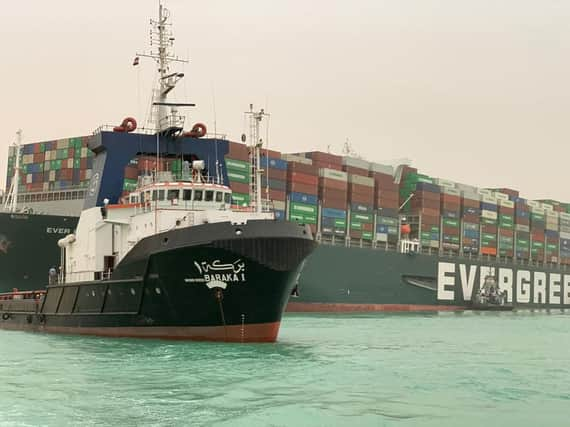Suez Crisis 1956: what was the Arab-Israeli war - and history of the canal explained


The 400m-long ship became lodged in the canal following a dust storm and high winds, with attempts to remove it thus far unsuccessful.
Some are calling the incident the “new Suez Crisis”, referring to the original Suez crisis - otherwise known as the second Arab-Israeli War.
What is the Suez Canal?
Advertisement
Hide AdAdvertisement
Hide AdThe Suez Canal is a man-made waterway which runs across the Isthmus of Suez in Egypt, connecting the Red and Mediterranean seas.
It separates Asia from Africa, and is the shortest route between Europe and the areas around the western Pacific and Indian Oceans - meaning it’s a vital shipping route for millions of tonnes of goods every year.
What was the first Suez Crisis?
The first Suez Crisis was a conflict that began on October 29, 1956, when Israel invaded Egypt - followed later by Britain and France.
The invasion was sparked after then-Egyptian president Gamal Abdel Nasser nationalised the Suez Canal in July 1956.
Advertisement
Hide AdAdvertisement
Hide AdThe canal had previously been owned primarily by Britain and France, and it was a valuable waterway which controlled around two-thirds of the oil used in Europe.
Tensions had been brewing for some time between the nations involved. Two years earlier, in the wake of the Second World War, Egyptian military forces had been putting pressure on the UK to end their military presence in the canal zone.
Egyptian armed forces, meanwhile, had also been battling with Israeli soldiers along the borders between the two countries.
Supported by money and arms from the Soviet Union, and angered by the United States rescinding their promise to fund construction of a dam on the Nile River, Nasser ordered the Suez Canal be seized and nationalised in July 1956.
Advertisement
Hide AdAdvertisement
Hide AdBritain was angered by the move, and sought support from France and Israel to try and retake the canal.
How did the crisis end?
The attempt to retake the canal ultimately failed, with President Nasser claiming victory.
When British and French forces began occupying the canal area, the move was met with growing opposition both in the UK and by US-sponsored resolutions made in the United Nations (UN).
The Soviet Union had warned against the invasion and threatened the west with missile launches unless the Israeli-British-French forces withdrew.
Advertisement
Hide AdAdvertisement
Hide AdIn December 1956, British and French troops were evacuated by the UN, and Israeli forces withdrew in March 1957.
What were the consequences?
The episode was widely regarded as humiliating for France and Britain.
The crisis resulted in Britain and France both losing influence in the Middle East, and for the former, marked the beginning of Britain’s decline in global power.
British Prime Minister Anthony Eden resigned from his post two months after troops were withdrawn.
Advertisement
Hide AdAdvertisement
Hide AdIsrael did achieve some of its aims, however, regaining shipping rights in the Straits of Tīrān.
President Nasser became a powerful hero figure for Arab and Egyptian nationalist movements following the crisis.
As a gesture of peace, Egyptian President Anwar el-Sadat eventually reopened the canal in 1975, which today serves as a hugely important route for shipping goods.